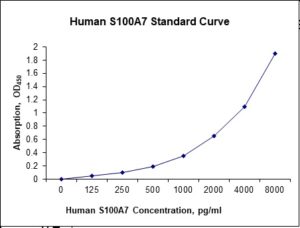Nori Human S100A7 ELISA Kit
$461.00 – $832.00
This ELISA kit is for quantification of S100A7 in human. This is a quick ELISA assay that reduces time to 50% compared to the conventional method, and the entire assay only takes 3 hours. This assay employs the quantitative sandwich enzyme immunoassay technique and uses biotin-streptavidin chemistry to improve the performance of the assays. An antibody specific for S100A7 has been pre-coated onto a microplate. Standards and samples are pipetted into the wells and any S100A7 present is bound by the immobilized antibody. After washing away any unbound substances, a detection antibody specific for S100A7 is added to the wells. Following wash to remove any unbound antibody reagent, a detection reagent is added. After intensive wash a substrate solution is added to the wells and color develops in proportion to the amount of S100A7 bound in the initial step. The color development is stopped, and the intensity of the color is measured.
Alternative names for S100A7: S100 calcium-binding protein A7, S100-A7, psoriasin
This product is for Laboratory Research Use Only not for diagnostic and therapeutic purposes or any other purposes.
- Description
- How Elisa Works
- Product Citation (0)
- Reviews (0)
Description
Nori Human S100A7 ELISA Kit Summary
Alternative names for S100A7: S100 calcium-binding protein A7, S100-A7, psoriasin
| Assay Type | Solid Phase Sandwich ELISA |
| Format | 96-well Microplate or 96-Well Strip Microplate |
| Method of Detection | Colorimetric |
| Number of Targets Detected | 1 |
| Target Antigen Accession Number | NP_002954.2 |
| Assay Length | 3 hours |
| Quantitative/Semiquantitative | Quantitative |
| Sample Type | Plasma, Serum, Cell Culture, Urine, Cell/Tissue Lysates, Synovial Fluid, BAL, |
| Recommended Sample Dilution (Plasma/Serum) | No dilution for sample <ULOQ; sufficient dilution for samples >ULOQ |
| Sensitivity | 25 pg/mL |
| Detection Range | 125-8000 pg/mL |
| Specificity | Human S100A7 |
| Cross-Reactivity | < 0.5% cross-reactivity observed with available related molecules, < 50% cross-species reactivity observed with species tested. |
| Interference | No significant interference observed with available related molecules |
| Storage/Stability | 4 ºC for up to 6 months |
| Usage | For Laboratory Research Use Only. Not for diagnostic or therapeutic use. |
| Additional Notes | The kit allows for use in multiple experiments. |
Standard Curve
Kit Components
1. Pre-coated 96-well Microplate
2. Biotinylated Detection Antibody
3. Streptavidin-HRP Conjugate
4. Lyophilized Standards
5. TMB One-Step Substrate
6. Stop Solution
7. 20 x PBS
8. Assay Buffer
Other Materials Required but not Provided:
1. Microplate Reader capable of measuring absorption at 450 nm
2. Log-log graph paper or computer and software for ELISA data analysis
3. Precision pipettes (1-1000 µl)
4. Multi-channel pipettes (300 µl)
5. Distilled or deionized water
Protocol Outline
1. Prepare all reagents, samples and standards as instructed in the datasheet.
2. Add 100 µl of Standard or samples to each well and incubate 1 h at RT.
3. Add 100 µl of Working Detection Antibody to each well and incubate 1 h at RT.
4. Add 100 µl of Working Streptavidin-HRP to each well and incubate 20 min at RT.
5. Add 100 µl of Substrate to each well and incubate 5-30 min at RT.
6. Add 50 µl of Stop Solution to each well and read at 450 nm immediately.
Background:
S100 calcium-binding protein A7 (S100A7), also known as psoriasin, is a protein that is encoded by the S100A7 gene.[1] S100A7 is a member of the S100 family of proteins containing 2 EF-hand calcium-binding motifs. S100 proteins are localized in the cytoplasm and/or nucleus of a wide range of cells, and involved in the regulation of a number of cellular processes such as cell cycle progression and differentiation. This protein differs from the other S100 proteins of known structure in its lack of calcium binding ability in one EF-hand at the N-terminus. The protein functions as a prominent antimicrobial peptide mainly against E. coli. S100A7 also displays antimicrobial properties. It is secreted by epithelial cells of the skin and is a key antimicrobial protein against Escherichia coli by disrupting their cell membranes. S100A7 is highly homologous to S100A15 but distinct in expression, tissue distribution and function.[2][3] S100A7 is markedly over-expressed in the skin lesions of psoriatic patients, but is excluded as a candidate gene for familial psoriasis susceptibility. The expression of psoriasin is induced in skin wounds[4] through activation of the epidermal growth factor receptor. S100A7 has been shown to interact with COP9 constitutive photomorphogenic homolog subunit 5,[5] FABP5[2][3] and RANBP9.[8] S100A7 interacts with RAGE (receptor of advanced glycated end products).[2][9]
References
- Madsen P, et al. (1991). J. Invest. Dermatol. 97 (4): 701–12.
- Wolf R, et al. (2008) J. Immunol. 181 (2): 1499–506.
- Wolf R, et al. (2009). Cancer Lett. 277 (1): 101–7.
- Lee KC, Eckert RL (2007). J. Invest. Dermatol. 127 (4): 945–57.
- Emberley ED, et al. (2003). Cancer Res. 63 (8): 1954–61.
- Ruse M, Broome AM, Eckert RL (2003). J. Invest. Dermatol. 121 (1): 132–41.
- Hagens G, et al. (1999). Mol. Cell. Biochem. 192 (1–2): 123–8.
- Emberley ED, et al. (2002). BMC Cancer. 2: 28.
- Winston J, Wolf R (2012). J. Dermatol. Sci. 67 (3): 205–7.
Be the first to review “Nori Human S100A7 ELISA Kit”
You must be logged in to post a review.





























Reviews
There are no reviews yet.